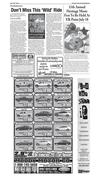071415_YKMV_A2.pdf
July 14, 2015 • Page 2
shop online at www.missourivalleyshopper.com
Dave Says
Unauthorized Subletting
gentle and nice but
really clear about
things. But this guy
needs to understand that you mean
what you say in the
lease agreement.
Once more, and he’s
gone!
—Dave
By Dave Ramsey
Dear Dave,
I own a rental property that brings in
enough to pay the taxes and insurance
with a little left over. Recently, I found
out that my tenant, who just signed a
new two-year lease, is subleasing the
property for the short term as a vacation site. This kind of thing happened
once before and is prohibited in the
agreement. Do you think I should approach him about the situation or let it
go until it becomes problematic?
—Catherine
Dear Catherine,
It’s already a problem, because he’s
in violation of the lease agreement. Call
him today and tell him to stop the sublease immediately. Let him know that
he’ll be evicted if anything like this ever
happens again.
This may sound harsh, but an
agreement is an agreement. You may
not have experienced any big problems
up until now, but what happens when
he pulls this again and the next people
who come in are a bunch of partiers?
You could end up with broken windows,
holes in the walls and a bad reputation.
On top of all that, what if they leave
and he doesn’t have the money to fix
things? It’s all on you. Why? Because
you lost control of your property!
As a landlord, I always try to be
Dave
Healing comes
first
Dear Dave,
I have a relative
who recently entered a rehab center to
treat her drug addiction. I’ve been trying to help with things on the outside,
and recently I discovered she has about
$20,000 in debt. This is in addition to
the rent owed on her apartment. I don’t
have a lot of money, but do you think I
should start trying to pay some of these
bills for her?
—Jeremy
Ramsey
Dear Jeremy,
I’m really sorry to hear about your
relative. Addiction is painful thing for
the addict and for their family and
friends. While what you’re suggesting
is noble, my advice would be to leave
the debt alone. I would, however, notify
her landlord of what’s happened. If he
won’t hold her place, then get her stuff
out and turn over the keys so he or she
can find another tenant.
As far as the debt obligations are
concerned, just let her creditors cry
and whine. They’re going to do that
anyway, and you’re in no position to
help financially at this point. Once she’s
out and healthy again, one of the first
things she’ll have to do is recreate her
life and income. When that’s been done,
then she needs to go back and make
arrangements with her creditors.
But right now, she needs to concentrate on herself. And as her family, you
need to pour as much love and support
as you can into the healing process.
You’ve got a great heart, Jeremy, but
the money stuff can wait until she’s out,
healthy and established again. Then, if
you want and have been able to save a
bit, you might gift her a little money to
help her get started again.
God bless you guys.
—Dave
Dave Ramsey is America’s trusted
voice on money and business. He has authored five New York Times best-selling
books. The Dave Ramsey Show is heard
by more than 8.5 million listeners each
week on more than 550 radio stations.
Dave’s latest project, EveryDollar, provides a free online budget tool. Follow
Dave on Twitter at @DaveRamsey and
on the web at daveramsey.com.
Economics & Ecology
Working Together
BROOKINGS, S.D. - By
returning their ranchland to
pre-settlement condition, a
South Dakota ranch family
put nature to work for them
with incredible results.
“Oftentimes we hear that
ecology and environment
don’t mix with economics,
but the Mortenson’s prove
you can have both. Their
ranch is beautiful, full of
native habitat and wildlife
which provide hunting and
other opportunities, but it is
also stocked with good quality cattle,” explains Carter
Johnson, Distinguished Professor of Ecology at South
Dakota State University who
painstakingly documented
the family’s journey in a recently released online book;
The Mortenson Ranch Story:
Balancing Environment and Economics.
“Ranching is a
tough job if you have
to do everything yourself, but if you can get
nature to work for you
- like the Mortensons
have done - the results are beautiful and
pay the bills,” said
Johnson, who met
the family patriarch,
Clarence Mortenson
in 1990 and began
conducting research
and documenting the
family’s restoration
progress.
“This story details Clarence’s conservation and
management philosophy
and how it has been implemented by three generations
of his family to restore the
ranch’s environment and
economy that ultimately
earned the Mortensons the
coveted Aldo Leopold Conservation Award in 2011,”
said Johnson in the book’s
Abstract.
Johnson explains that
Clarence grew up in the
early years following the
Dust Bowl. As a young boy,
he learned from an old
homesteader how beautiful
and productive the heavily
eroded and barren landscape once had been. “Clar-
MOODY
ence vowed that if and when
he took over the ranch he
would get it back to its presettlement condition of thick
grass, clear-water streams,
dense woody draws and
abundant wildlife. But the
ranch was not to be a “preserve,” it had to provide a
sustainable living for a large
family,’” Johnson wrote.
He added. “In my 40 years
of studying riparian woodlands in many states, never
have I met producers with
more enthusiasm, dedication, and genuine interest in
restoration and conservation
as the Mortensons.”
For five decades, the
Mortensons have invited
SDSU students, faculty,
researchers and SDSU Extension to not only conduct
research on their land, but
to use it as an outdoor classroom where other ranchers
and landowners could see
firsthand how various restoration projects worked to
enhance the land for wildlife
as well as cattle.
Johnson says that what
makes all the research on
the Mortenson’s land unique
is Clarence’s extensive
knowledge of the land’s history. “This book chronicles
close to 100 years of history.
We probably know more
about this ranch than almost
any other in the state,” Johnson said.
Along with scientific data
and details on the Mortenson’s restoration projects,
the book contains historical information as well as
photos. “I sort of turned into
their family’s biographer
by accident. It was not an
easy role because I’m not
a biographer. But I did my
best to pull together what
we learned during those
25 years and more,” said
Johnson. “My overall goal
was to pull scientific as well
as experiential information together so that other
ranchers can read, relate
and implement projects to
help them restore their own
ranches.
Today the ranch is managed by Clarence’s son Todd
and his wife Deb, together
with their sons Jack and
Quinn.
“Each generation has
done something different to
improve it. I still see areas
that I can improve upon, and
I want to be sure that when
I hand this over to my boys,
it is as good as I could do
and, hopefully, it will continue with them,” said Todd
Mortenson, as quoted in the
2011 Leopold Conservation
Award Bulletin. niGrow
Waterproof Boots/Shoes
MOTOR
NIOBRARA, NE
Over 20 Styles To Choose From And On Sale!
Keep those toes dry!
Patrick Hawk
Boston 3rd • Yankton • to Boots
Shoes 665-9092
312 W.
FREE Socks
With Boots!
251 Spruce Ave • Box 260
Niobrara, NE 68760
www.moodymotor.com
pjhawk@hotmail.com
(402) 857-3711
(800) 745-5650
Fax (402) 857-3713
You Are Invited...
Home and Personal Property
AUCTION
Sunday, July 26 -- 12 noon
REAL ESTATE SELLS FIRST followed by personal property
Yankton Baptist Church
This is your invitation to attend Worship: Sunday
morning at 10:45 am or Wednesday evening at
7pm. Our Worship Center is located at 607 E. 15th,
Yankton, SD. See you there!!
Phone: 605-665-7587
Text: 434-665-2467
www.yanktonbaptistchurch.com
Windy Wilson was on the prowl, this beautiful Independence Day morning, searching the neighborhood for something
to do for others. He decided to let his weekly day helping
others come on the Fourth this week, because he was feeling
very American.
Let’s see … he thought … I can circumlocute over
to Mrs. Hennessey’s and see if her flower garden needs weeding. She’s got very close veins and the sugar diabeets, and
getting around ain’t easy.
He headed in that direction when he came across
two friends of his arguing over politics. They were standing there in the shade of an elm tree and trying seriously to
tear down each other’s theory on how the world, the United
States, the state government and the local school board
should be operated. Windy stopped and listened to them.
Each would look at Windy as each point was made only to see
the usually garrulous Alphonse Wilson smile benignly and
nod in response.
Pretty soon, the two combatants figured out that Windy
was nodding to statements on totally opposite sides of the
argument. They stopped and looked at him.
“How do you stand on this, Windy?” one asked.
“I stand as an American citizen,” he said, “on this recompensation of our Independence Day, knowing that our foundling fathers would want it this way. Yes, since this is a special
day for all Americans, I am recumbent in the factotum that it
is your very basic right to be wrong.”
“Which one? Which one of us is wrong, Windy?”
He grinned. “Well … you both are.”
Effective Pinkeye
Treatment this Summer
BROOKINGS, S.D. - Warm
weather has many cattle
producers concerned about
pinkeye, the common name
for infectious bovine keratoconjunctivitis (IBK), which
is one of the most common
and economically damaging
cattle diseases.
“Pinkeye is a contagious
disease causing inflammation
of the cornea and conjunctiva. If left untreated, severe
damage to the eye may
occur,” said Janna Kincheloe,
SDSU Extension Research
Associate.
Each year, cattle producers lose an estimated $150
million due to reductions
in weight gain, decreases in
milk production, treatment
costs and potential price discounts for affected animals.
Kincheloe added that the
climate this growing season
is optimal for pinkeye. “Moist
conditions and lush forage
can create optimal conditions for pinkeye, as wet
weather typically increases
the incidence of face flies
that irritate eyes and help
spread the disease,” she
said.
In addition, tall grass can
irritate eyes when cattle
lower their heads to graze.
Prevention is multipronged
Preventing the disease
typically requires a multipronged approach, explained
Russ Daly, Professor, SDSU
Extension Veterinarian.
“The most effective way to
deal with pinkeye is to stay
ahead of it by integrating
prevention with broad-based
treatment strategies developed in conjunction with a
veterinarian as part of a herd
health management plan,”
Daly said.
He explained that an
effective plan often includes
vaccination, fly control and
managing the grazing environment. He also noted that
it takes approximately 4 to
6 weeks to get maximum immune response from vaccine,
so producers should plan
accordingly and vaccinate
prior to observing a disease
outbreak in the herd.
In some cases, veterinarians may recommend using
sterile swabs to take samples
from affected eyes in
order to grow the causative
bacteria for an autogenous
vaccine.
“Autogenous pinkeye
LOCATED: 415 North Main Street, Kaylor, SD
Real Estate consists of a very clean 1 story 2 bedroom home
with full basement, 22x28 detached 2 car garage and 16x24 storage building. Situated on a 150x182 lot this home features many
updates including a new propane furnace with elec heat pump
and a/c and all new wiring in 2014, plumbing updates plus many
more recent improvements. Most major appliances included.
LEGAL DESCRIPTION: W 150’ of Lot A.
TERMS & CONDITIONS: $4000 non-refundable down payment day of auction with balance due at closing. Title Insurance and closing service fees split
50-50 between buyer and seller. 2015 taxes prorated to closing. Possession
upon receipt of ?nal payment. Announcements day of auction take precedence
over printed material. Peterson Auctioneers are representing seller
Real estate may be viewed by appointment
call Glen Peterson, 605-369-2638
July 15th - July 29th
Hot Deals on all Hot Tubs!
Close out prices on select models
Included are shop, lawn and garden equipment and household.
Many new in the box or near new items. All very clean and well cared for.
A complete listing will appear in a future issue
Gerald Maruska, Owner
Glenn Roth, escrow and closing agent phone 605-387-5530
www.petersonauctioneers.com
Lee Wittmeier, Tyndall, SD
TERMS: CASH
Not Responsible
for Accidents
LEISURE WORLD, INC.
1900 Broadway Ave, Yankton, SD • 605-665-1240
2500 S. 13th St., Norfolk, NE • 402-371-8425
w w w.leisureworldsd.com
vaccines, as well as overthe-counter vaccines, have
not uniformly resulted in
complete protection from
the disease, but may be useful in certain situations,” he
explained.
Daly added that even if
preventative measures are
in place, it is important to
be able to detect and treat
pinkeye early.
Below, Daly and Kincheloe list some signs of early,
active and healing stages of
the disease as well as some
specific treatment recommendations.
Pinkeye Detection &
Treatment
Early stage: Clinical signs
of pinkeye are consistent.
Within the first three to
five days of infection, cattle
blink frequently and have
excessive tearing and there
is redness in the conjunctiva
(white part) of the eye.
“Cattle in this beginning
stage will often seek shade,
typically decreasing the time
they spend grazing,” Daly
explained.
Pain may also contribute
to reduced feed intake. After
a day or two, he explained
that these signs progress to
a small ulcer in the center of
the cornea which appears
as a small white spot. “The
cornea develops a cloudy
blue-grey appearance due to
inflammation. One or both
eyes may be affected, and
the eye(s) are often held
shut due to pain,” he said.
Treat early: The key to
treating pinkeye effectively
is to treat early. “The goal
of early pinkeye detection
and treatment is to eliminate
the causative agent (most
typically Moraxella bovis
bacteria) by using longacting antibiotics, often
tetracycline,” Daly said.
Kincheloe added that
commercially available, nonantibiotic antibacterial topical treatments may also be
effective in helping to alleviate pain and discomfort and
speed the healing process.
“Producers should consult
with their veterinarians to
determine optimal treatment
strategies for individual situations,” she said.
Active Stage: If left
untreated in the early stage
of the disease, the ulcer will
continue to spread across
the cornea, and the eye will
become increasingly cloudy.
“Blood vessels from the
outside of the cornea begin
to grow to help with healing,
which gives the cornea the
classical pink appearance,”
Daly said.
He explained that the
ulcer will eventually cover
most of the cornea and the
inflammation will spread to
the inner parts of the eye. If
this occurs, the inside of the
eye fills with a pus-like substance called fibrin that gives
the eye a yellow appearance.
Rupture of the eyeball is
rare but may occur with a
severe infection.
Aggressive treatment is
critical
In order to prevent any
further damage, aggressive
treatment with long-acting
antibiotics is critical at this
stage of the disease. Additionally, Daly said there
n pinkeye,
Page 5















 Previous Page
Previous Page




